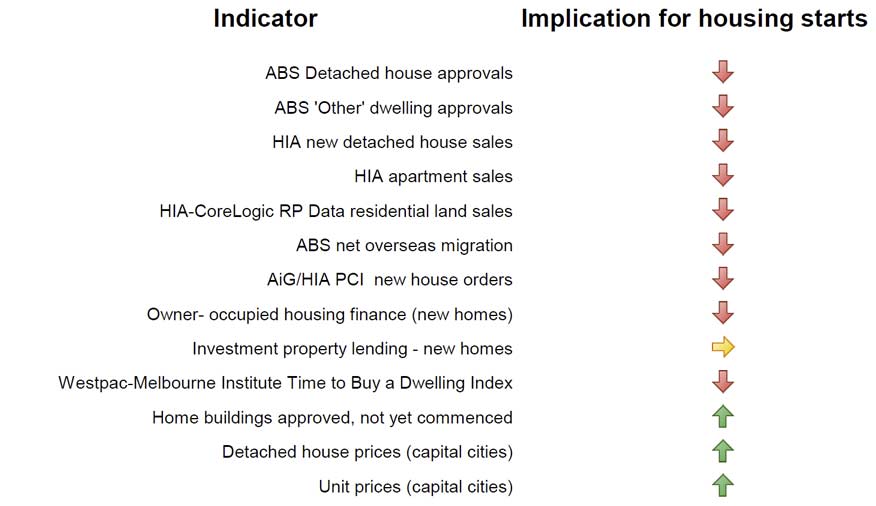The HIA has published “The Residential Outlook for 2016”.
In 2015 new dwelling commencements increased for a third consecutive year in 2014/15 to a record high of 211,860. It is only the fifth time in the past sixty years that commencements (housing starts) have racked up three straight years of growth. The record level of nearly 212,000 starts is 13 per cent higher than the previous cyclical high of 187,000 reached all the way back in 1994.
Renovations activity is still grinding out a recovery, with little sign at this stage of accelerating momentum.
The residential property price growth cycle has peaked, but it’s a very disparate geographical story – if you don’t live in Sydney or Melbourne then you don’t have a boom.
Looking forward, there is upward momentum evident for only three out of thirteen variables (plus we’re calling investment lending for new properties as being ‘neutral’, although some would call it down), compared to six pointing up in the middle of the year and ten last summer. As of the end of 2015, nine variables are now pointing down. This is the weakest HIA/ACI Housing Indicator Profile in over four years.
 The key points to note about this housing cycle are:
The key points to note about this housing cycle are:
- the changing mix of what we build;
- the large geographical divergences across states and territories;
- the downside risk to new home construction from 2016/17.
There are very different trajectories evident for the various types of building approvals and dwelling commencements reported by the Australian Bureau of Statistics – semi-detached dwellings compared to units of four storeys or more, for example. The dwelling composition forecasts produced by Australian Construction Insights, the consultancy arm of HIA Economics, suggests further upward momentum in the short term for: detached houses; semi-detached dwellings (of two storeys); and units of one or two storeys.
On the topic of geography, momentum is clearly with the eastern seaboard markets, including some renewed promise for the southeast corner of Queensland. New South Wales is the strongest housing market in Australia, followed by Victoria. The Scorecard has accurately picked the shifting geographical sands for housing markets over the last couple of years, as has the CommSec State of the States report in terms of broader domestic economic conditions.
HIA is forecasting a modest decline of 5.5 per cent in national new dwelling commencements in 2015/16 to a level of just over 200,000. On a calendar year basis commencements are expected to hit 211,490 in 2015, but we see upside risk to this forecast.
In other words, the formal peak for the cycle could turn out to be calendar year 2015 rather than fiscal year 2014/15. The eastern seaboard will drive the short term health of Australia’s new home building sector.
HIA suggest a growth in the value of renovations of 1.6 per cent in 2017/18 and 3.7 per cent in 2018/19 to boost the value of Australia’s renovations market to $31.20 billion.
Australia’s only two strong dwelling price markets – Sydney and Melbourne – will experience a slowing rate of growth in 2016 as the cycle continues to run out of puff. No doubt that trend will provide the doom-sayers with plenty of opportunity to write exaggerated headlines and try to scare the living daylights out of people.
The fact is, outside of Sydney and Melbourne the term ‘housing price boom’ seems like a foreign language. Brisbane was showing signs of joining the eastern seaboard club this time last year – as we noted at the time – but a lack of population growth capped that situation rather quickly. As of November 2015 Brisbane was still the third fastest growing state capital residential property price market in the country behind Sydney (+12.8 per cent yoy) and Melbourne (+11.8 per cent yoy), but at 4.0 per cent per annum you would hardly call Brisbane a boom market.
The aggregate price cycle, heavily masked by Sydney and Melbourne, will continue to experience decelerating growth. Sydney and Melbourne are our two biggest markets and it is appropriate that price growth is slowing. Variable mortgage rates are on the rise under the guise of covering increased funding costs and there may be more of that to come in early 2016. That will dampen price growth. The rationing of credit overseen by APRA has occurred more broadly than justified.
